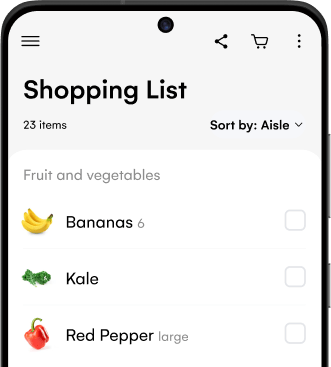A new diet fad arises each year. The trend of cutting out fat or limiting carbs comes and goes. Sometimes people stop eating fat entirely. But there’s a reason why national dietary guidance doesn’t encourage you to eliminate entire food groups. There are good reasons why you should eat all food groups and not eliminate any major part of a balanced diet.
Plan meals together! Share this plan with your family

If you want to be fit and healthy and give your body the nutrients it needs to perform at its peak, then you must allow yourself to eat all the food groups. Sure, you may want to tweak the ratios in which you eat them. And you might even be successful with crash dieting to achieve short-term goals, but these don’t last.

What are all the food groups?
Food provides essential vitamins and minerals to help your body function healthily. The largest group of nutrients is called macronutrients (macros for short) and encompasses the three main food groups.
- Carbohydrate.
- Fat.
- Protein.
Each of these macros has its own purpose within the body. Your body must have nutrients from each macro to function optimally. Then of course, you have extra considerations like fiber, vitamins, and minerals too.
The current Dietary Guidance for Americans recommends you divide your macro consumption as follows:
- Carbohydrates: 45-65 percent.
- Protein: 10-35 percent.
- Fat: 20-35 percent.
Of course, finding the right balance of protein, fat, and carbs for your health goals is important. You might eat more protein if you want to build muscle. Or might find you do better with a lower carb diet, especially during a break from training. But typically, you should include all of the three major food groups.

The low down on protein
One gram of protein contains 4 calories.
Protein is essential for building and repairing muscle. Think of protein as the building blocks of your body.
Protein consists of 22 amino acids. Your body is clever; it can make some of these amino acids itself. “Non-essential” amino acids are the amino acids your body can make. The amino acids which must be consumed in the diet and can’t be made by your body are called “essential” amino acids.
Well-known protein sources include meat and dairy, which are all complete protein sources. But if you’re vegetarian or vegan, you can still meet protein goals – you just have to eat a variety of them.
Here are some of the healthiest protein sources:
- Quinoa.
- Legumes (beans, peas, and lentils)
- Lean meats.
- Fish.
- Eggs.
- Lentils.
- Nuts and seeds.
- Soy
If you don’t eat meat, it’s good to know that both soy and quinoa are complete proteins and contain all the essential amino acids.
The issues with inadequate protein
If you scrimp on the protein, your body won’t be able to build and repair your muscles adequately. Inadequate protein consumption will hinder your recovery from exercise and limit your future exercise performance. It will also prevent you from making muscle gains.
Other consequences of protein deficiency include:
- Restless sleep.
- Increased fat storage.
- Reduction in lean muscle.
- Injury.
- Foggy brain.
- Feeling fatigued.
If you are exercising regularly, it’s essential to consider your protein consumption – not just the quantity, but also the timing of your protein intake. This study in the Sports Medicine journal recommends that those who participate in regular exercise consume 1.8 grams to 2 grams of protein per kilogram of body weight daily.
Consider adding a protein shake if you’re struggling to meet your goals. They’re particularly valuable after exercise in order to help repair your muscles and build lean muscle mass.
Install free Chrome extension for easy recipe saving

The low down on carbohydrates
One gram of carbohydrate contains 4 calories.
Think of carbohydrates as the fuel your body needs to move. Your body turns carbohydrates into glucose, which becomes energy. Fiber is a type of carbohydrate too. While it doesn’t contribute to energy, it is essential for a healthy gut and regular bowel movements.
Unfortunately, carbohydrates are something people regularly cut out of their diet even when they should eat all food groups. That doesn’t mean loading up on fries, but it does mean incorporating good sources of carbs into your meals.
Carbohydrates come in two forms: simple carbohydrates and complex carbohydrates. An easy way to differentiate between the two is to remember that simple carbohydrates are often sweet and provide quick energy. Complex carbohydrates are generally savory and provide longer-lasting energy.

Simple carbohydrates include:
- Fruit.
- Honey.
- Anything with refined sugar.
Complex carbohydrates include:
- Pasta.
- Bread.
- Rice.
- Starchy vegetables.
Keep in mind that opting for wholegrain carbs is typically a better choice – brown rice, wholegrain bread, or wholewheat pasta for example.
Possible catastrophes of going low carbohydrate
The Atkins diet and the keto diet both focus on reducing carbohydrate consumption. Many people who have tried these diets swear by this method to aid weight loss. And they often are effective, thanks largely to the calorie deficit which is created by cutting out a food group.
However, it is essential to be aware of the risks.
Firstly, inadequate carbohydrates can lead to relative energy deficiency in sports (RED-S). Symptoms of RED-S include:
- Poor concentration.
- Irritability.
- Low Motivation.
- Poor sleep.
- Anxiety.
- Low mood.
- Fatigue.
Secondly, carbohydrates are essential to fuel your body. But did you know it is also critical for your mental health? According to this study, there are direct links between diets low in carbohydrates and high in fat and protein and mood disorders such as anxiety and depression.
And if you’re replacing carbs with saturated fats like cream or high-cholesterol foods like processed meats, you could find yourself struggling with additional health problems too.
Make sure to fuel adequately before you exercise.

The low down on fat
One gram of fat contains 9 calories.
Fat is not a dirty word. But these days, fat is synonymous with negative connotations. Your body uses fat to protect vital organs, provide energy, make hormones and absorb vitamins.
There are three different types of fat:
- Trans fat.
- Saturated fat.
- Unsaturated fat.
The trans fats aren’t a healthy choice, and cutting them out of your diet won’t have any negative effects on your body. Trans fats include margarine spreads and fried foods. Most trans fats are hydrogenated oil.
Saturated fats can result in high cholesterol and increase heart disease risk if consumed excessively. You can find saturated fats in fatty animal products, such as some meats and full-fat dairy. They are often high in cholesterol too, but can be consumed in moderation.
Unsaturated fats are the good guys! They can serve to protect you from heart disease. Examples of foods high in unsaturated fats include:
- Nuts.
- Olive oil.
- Avocado.
- Olives.
- Nut butter.
- Fatty fish.

Consequences of restricting your fat consumption
Your body will break down if you don’t get adequate fat in your diet. Inadequate dietary fat means you won’t be able to absorb the vitamins needed to function healthily, leaving it vulnerable to disease and deficiencies.
Inadequate fat consumption leads to:
- Increased risk of disease and illness
- A compromised immune system.
- Mental health disorders.
- Eating disorders.
Wherever possible, use unsaturated fats as your fat source.
All food groups in balance
Each macro has an essential role to play in the healthy functioning of your body. Set your body up for optimum health and performance by trying to eat all food groups in adequate quantities. Completely eliminating one is likely to create health issues, as well as performance issues.
A balanced diet helps you lead a happy life and can boost your overall wellness. So we definitely don’t want to demonize an entire macronutrient!
Words by Ali Hall



